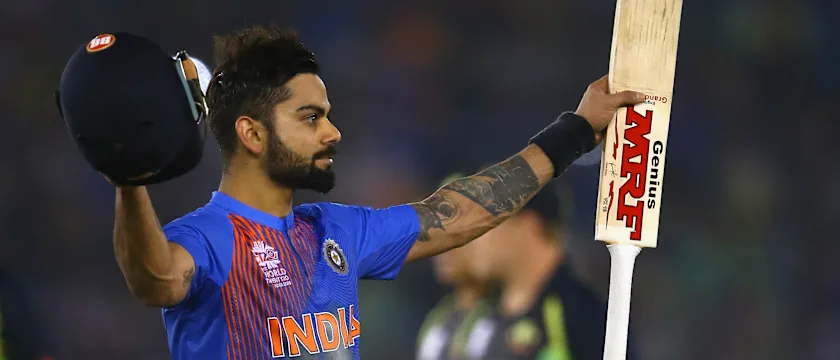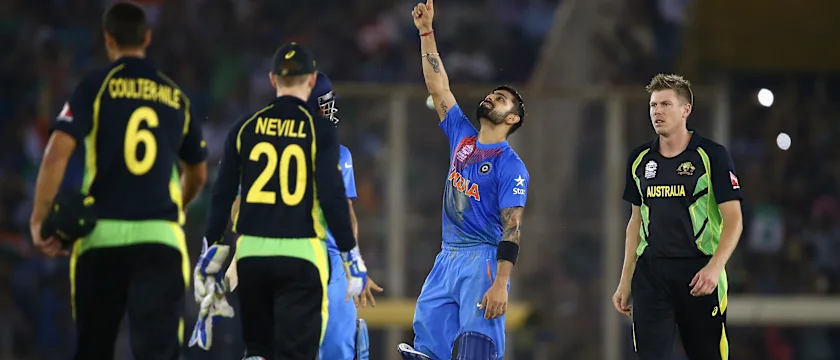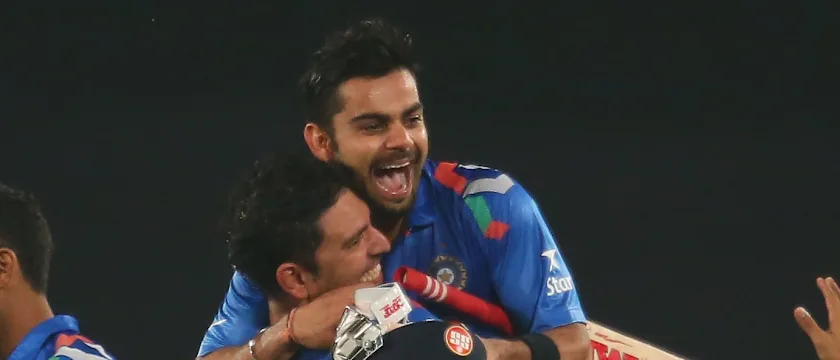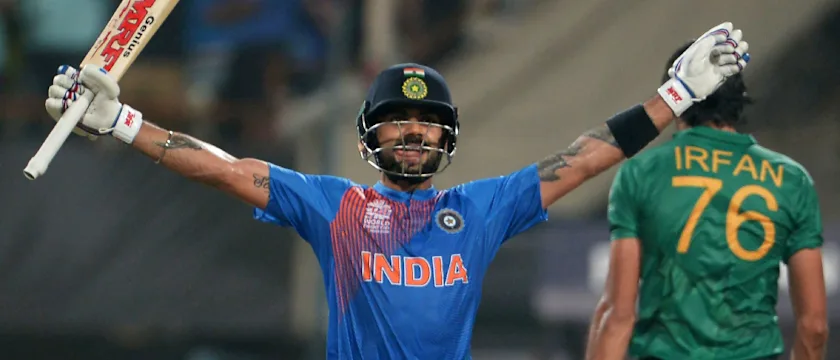Magic Mohali and an Eden Gardens classic: Kohli's road to 3000 T20I runs

Kohli became the third player to reach the 3000-run mark in T20I cricket during the second match against England, following New Zealand’s Suzie Bates and the West Indies’ Stafanie Taylor.
Already boasting an average better than 50 in both Test and ODI cricket, Kohli’s mean of 50.86 in T20I cricket is the best of any batter who has played at least 20 innings.
It was always a case of when, not if, he passed 3000 runs in the format.
Here, we look back at some of his best innings in the format so far.
Who else could it have been?@imVkohli became the first player to score 3000 runs in men's T20Is last night 👏#INDvENG pic.twitter.com/iK87PmnCNF
— ICC (@ICC) March 15, 2021
82 not out vs Australia, T20 World Cup 2016
Seen by many as Kohli’s finest T20I innings, and among his best in any format, the Indian maestro walked out to bat with the hosts in trouble at Mohali and produced an otherworldly performance.
The final group match for both teams, India’s meeting with Australia was a quarter-final in everything but name. The winner would book a spot in the semi-finals. The loser would have their tournament crash to a halt.
Chasing 161 to win, India’s start was less than ideal as Shikhar Dhawan (13) and Rohit Sharma (12) both fell inside the Powerplay. When Suresh Raina perished, India were limping at 49/3 and Australia were favourites.
Things got worse when Yuvraj Singh rolled his ankle, limiting India to only the safest of runs between the wickets. Kohli had made his way to 35 off 30 when Yuvraj fell to James Faulkner at the end of the 14th over. He had hit two fours and a six and India’s required run rate had ballooned to 11.17.
By the end of the 17th he had made his way to 50 off 40 and India needed 13 an over. On paper, the match was leaning Australia’s way. In reality, Kohli had the game exactly where he wanted it.
That became abundantly clear in a 19-run 18th over. The first delivery from Faulkner was short and kept low, so Kohli pulled it off the front foot for four. The second was right in the blockhole, so Kohli pushed it through cover-point for four. The third was full, so he charged and lofted it over long-off for six, paying no attention to the man on the ropes. It was calculated destruction.
In the following over, Nathan Coulter-Nile’s second delivery was full and on fourth stump, and Kohli guided it through point for four. The third was short and into the ribs, so he stood tall to pull backward of square leg. On his fourth, Coulter-Nile went back to a length delivery and Kohli stepped to the legside to open up a drive over extra cover for yet another boundary. He finished the over with yet another sumptuous cover drive and India only needed four runs to win.
As MS Dhoni finished the match with a slog over long-on, Kohli sunk to his knees. He had done it.
In an interview with Steve Smith last year, Kohli hailed it as his favourite innings.
“I went into a trance mode,” he said. “I still don’t understand how it happened to date. And it was like everything I was hitting was going into the gaps and I just went into the zone that I couldn’t breakdown after, that was so special.”

72 not out vs South Africa, T20 World Cup 2014
At the time this was the innings Kohli rated his best in T20I cricket.
Playing South Africa in the semi-finals of the ICC Men's T20 World Cup in Dhaka, India needed 93 runs off the final 10 overs.
At that stage in the innings, Kohli was on 17 off 16 and while the world knew he was quite the batter, the heights of his abilities were still being uncovered. This was a performance that would go some way to stamping Kohli’s name among limited overs cricket’s finest chasers.
He started the 11th over by clearing long-on off the bowling of JP Duminy for six but that was not the start of an all-out blitz. Instead, the rising star chose to play the role of an anchor, letting Yuvraj and Suresh Raina look for boundaries as he picked them where he could while still keeping things ticking over.
His next boundary was not until the 13th over and the one after was in the 16th. That was a six over mid-wicket to take him to his half-century in just 34 balls despite having only hit three boundaries at that point.
His presence in the middle allowed Raina to come out swinging, blasting 16 runs off the first six deliveries he faced, leaving India needing 23 runs off the final 18 deliveries.
With the match in the balance, Kohli hit two boundaries off Dale Steyn in the 18th over and another in the 19th from Beuran Hendricks to effectively end the match. He brought it to a real close in the 20th with another boundary off Steyn.
"Depending on the importance of the match, yes, you can say it is my best T20 innings," Kohli said at the time. "But I have struck the ball better in T20s in other games. I have also timed the ball better than I did today and have managed to score five or six boundaries very fast. Today it was difficult as I had to work hard for the knock. But as per the importance of the game, this knock tops it.
"I wanted to play an important knock when the team had entered the semis. I was in good form, so I thought it is better that I stay till the end. In T20, it is very important that a batsman stays till the end.
“It's not like there was no pressure. It wasn't easy. Pressure was there. But it is important that you don't show it to the opponents. They are a world-class attack and the slightest mistake against them can cost you. I just wanted to stay calm and was keen to back myself."

55 not out vs Pakistan, T20 World Cup 2016
After their surprise loss to New Zealand in their first game of the tournament, India needed to beat Pakistan to keep their fate in their own hands.
Things weren’t looking good for the tournament hosts as Kolkata was lashed by rain in the two hours before the scheduled toss. Eventually, the weather relented and an 18-over-a-side match was possible.
Sent out to bat, Pakistan managed a total of 118/5 on a pitch that was offering plenty to the spinners.
By the fifth over of the chase, India found themselves in trouble at 23/3 after Mohammad Sami accounted for Dhawan (6) and Raina (0) with back-to-back deliveries.
On a surface where scoring at a run-a-ball was proving difficult, Kohli scored 55 off 37, using his incredible speed between the wickets to keep things ticking over while avoiding big strokes down the ground in the early stage of his innings.
His first boundary was testament to that as he steered a wider delivery from Sami through backward point. His first shot of note through the covers did not come until the 13th over at which point he was in the 30s.
By that stage, he had come to grips with the surface in a way no other batter had. The first cover drive for four off Shahid Afridi was followed by another off Mohammad Amir in the 14th and then again off Afridi in the 15th. All three drives came with the bat as close as possible to the body as Kohli played risk-free cricket at a game-deciding pace.
In the end, it was Dhoni who hit the winning runs but it was those three cover drives and the intelligence shown before it that decided the game.

94* vs West Indies, 2019
Truly an innings of two halves.
Chasing 208 to win against West Indies, Kohli struggled early on.
At the halfway point in the chase he had soaked up 20 balls for 20 runs and none of it had looked calculated.
On the 22nd delivery Kohli faced he came close to chopping on but instead picked up a four via an inside edge past leg stump. In the 12th over he looked to clip a ball from outside off behind square, exposing all three stumps and got away with a leg bye. He went on to top edge a six and pull a four that same over but still looked far from set.
It was not until the 15th over that things really kicked into gear for the Indian captain. With a lofted drive over long-off against Jason Holder he raised his half-century and he followed that with a cut over the infield for four.
In the 16th over he laced a drive flat back over Kesrick Williams head for four and then sent another over long-on with plenty of wrist work. He used those wrists again to whip Kieron Pollard over deep mid-wicket for another six in the 18th over and then finished it in the 19th with two more maximums off Williams.
“To young batsmen watching, don't follow the first half of my innings,” he said after the match. “I was batting poorly at that time.
“I didn't want to put KL under pressure but I couldn't get going. Luckily got that one over from Holder, and then I began to analyse why I'm going wrong. Realised I'm not a slogger but a timer instead, and then changed my playing style.
“I'm not someone who wants to entertain by hitting in the air. The aim is not to play slam-bang cricket.”